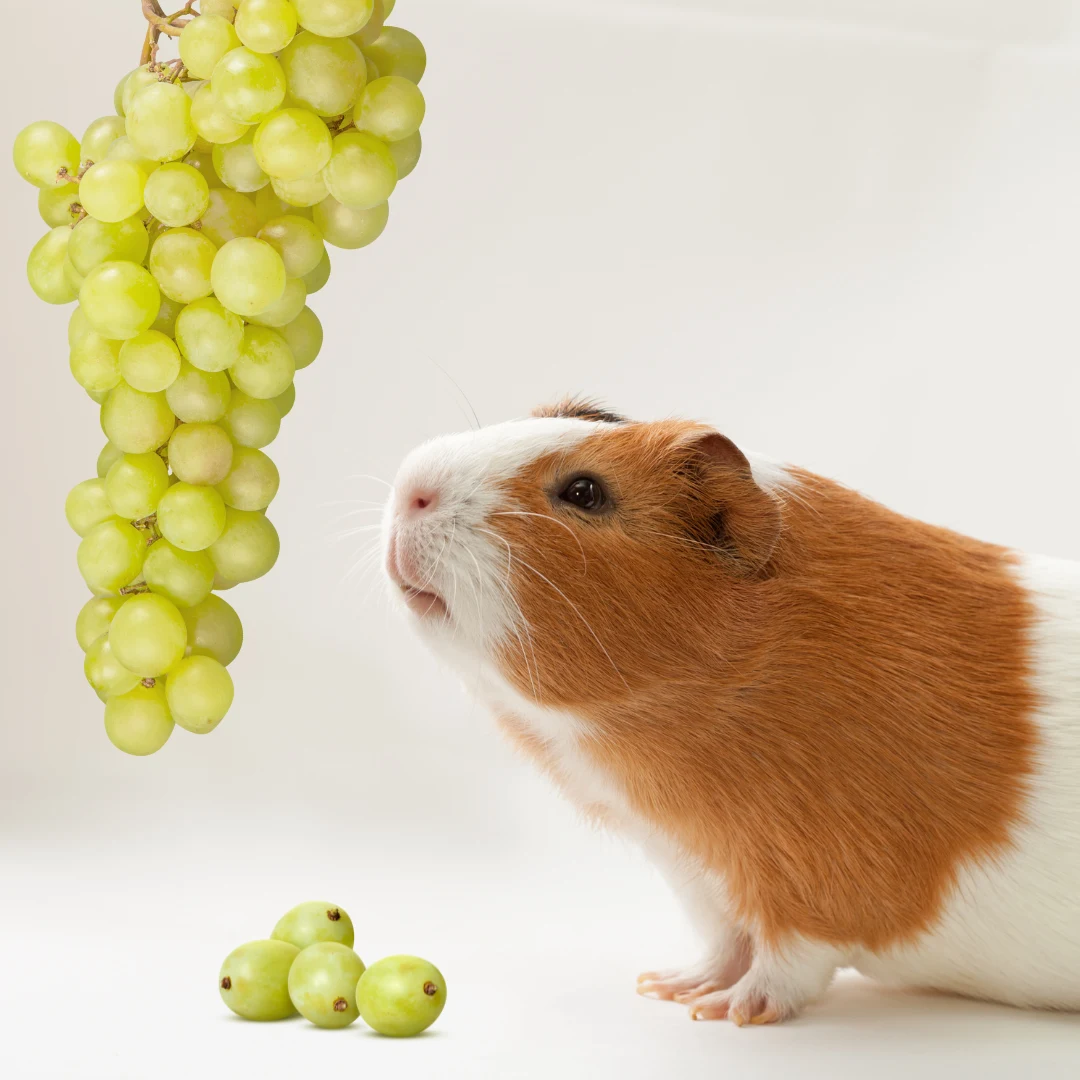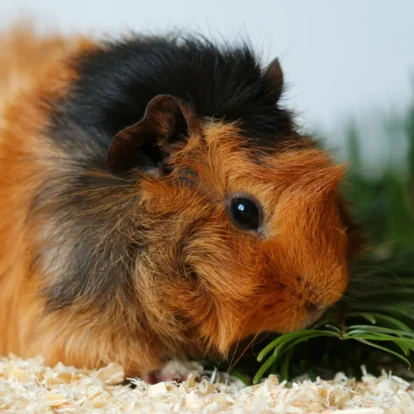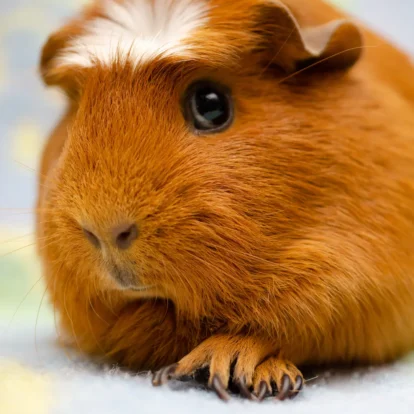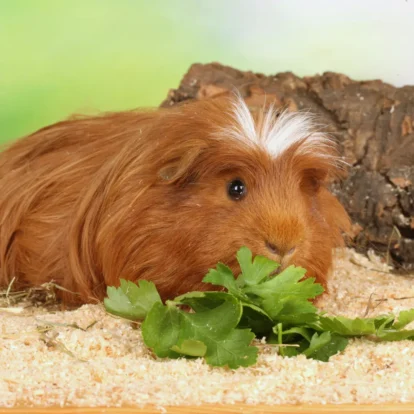Table of Contents
Introduction
Hello, fellow guinea pig enthusiasts! 🐹 If you’ve ever pondered the question, “Can guinea pigs eat grapes?” then you’ve hopped right into the perfect spot. As a proud piggie parent, I’ve gone through the grape debate myself and am excited to share what I’ve learned.
With their juicy sweetness, grapes might seem like a tempting treat for your furry friends. Still, it’s crucial to understand the ins and outs of introducing this fruit into your guinea pig’s diet.
In this post, we will dive deep into the grape conundrum—breaking down the nutritional information, the juicy dos and don’ts, and how grapes stack up against other treats. It’s essential to consider factors such as sugar content and its role in a healthy diet for our whiskered companions.
We’re not just talking about our little friends munching on grapes; we’re also going to chat about vegetables, seeds, peels, stems, and -spoiler alert 🚨- how to serve them all correctly.
As a dedicated guinea pig caretaker, I’ve also experimented with feeding grapes to my own fluff balls, weighing the joy of an occasional grape against the staple diet of hay, moderation in treats, and the necessity of diverse nutrients.
While some animals may thrive on only grass or specific leafy greens, others have more varied dietary needs. Our cavies fall somewhere in between, relying on a balanced mix of foods, from grass hay to oat hay, with suitable vegetables and fruits.
So please sit back, grab a bunch of grapes for yourself, and let’s get to the bottom of whether our guinea pigs can share in the vineyard’s bounty. 🍇🌱
Can Guinea Pigs Eat Grapes?
TL;DR: Can Guinea Pigs Eat Grapes?
Yep, guinea pigs can eat grapes, but it’s a bit like giving candy to a kid—best kept as a rare sweet treat! 🍇✨
In-Depth Exploration
As an ever-curious guinea pig parent, I’ve navigated the maze of what’s safe and what’s not. Let me share some grape truths: Not all snacks are created equal for our pets, and what works for dogs may not work for our little squeakers. The opposite is also true. Here’s the juicy detail: although guinea pigs can enjoy grapes, there are a few key things to remember.
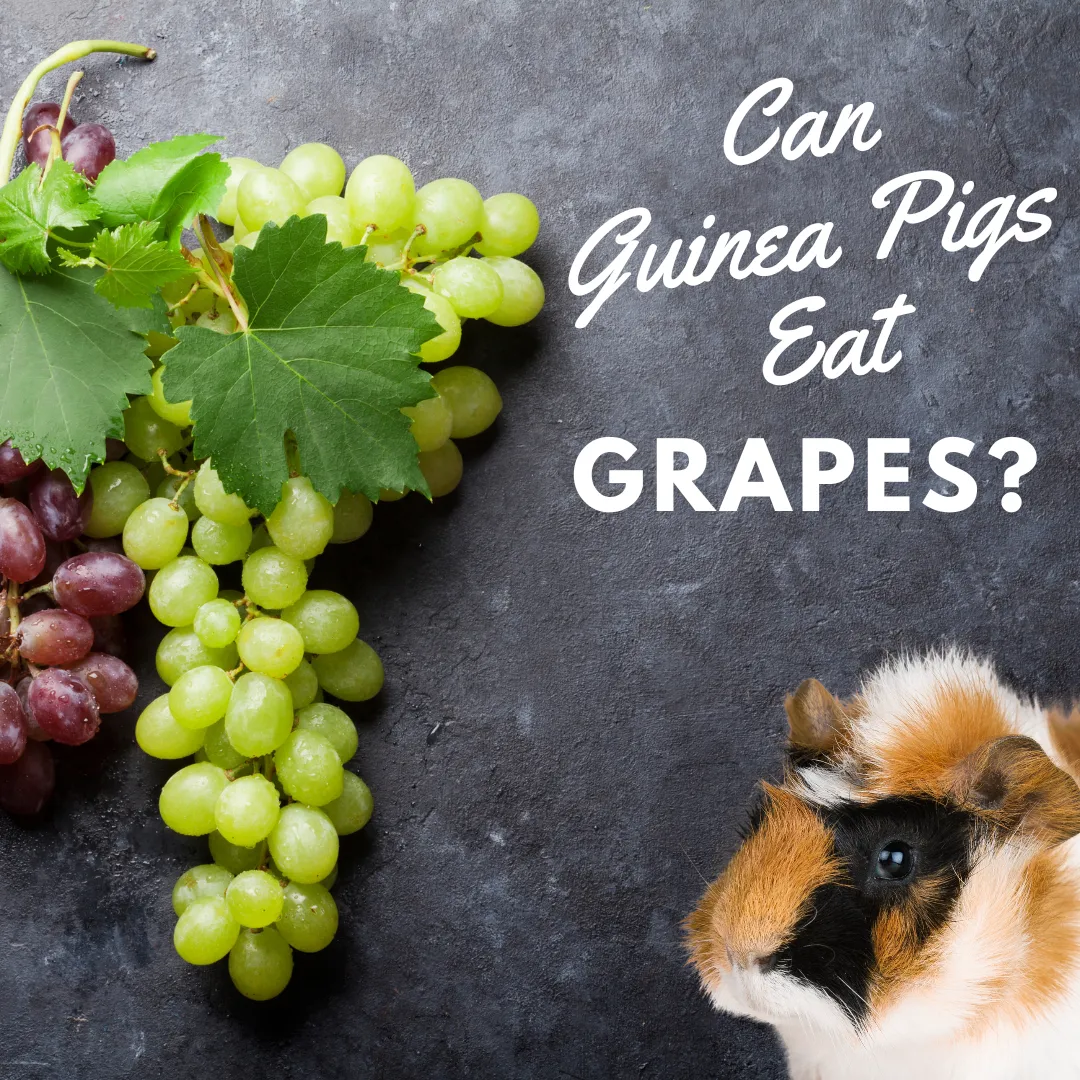
First off, whether we’re talking red or purple grapes, seedless is the way to go. Our pint-sized pals don’t need to navigate around pesky seeds, and honestly, seedless makes life easier for all involved. As for the health benefits, grapes are packed with vitamins but are also high in sugar content. So moderation is super important.
I remember the first time I treated my fluffy crew to a small grape each—the delight in their beady little eyes! But as tempting as it is to spoil them, I’ve learned that grapes are to guinea pigs what chocolate is to us—fine in a small amount, but not a main course.
Grapes should never replace what’s truly essential: a solid base of grass hay, plenty of fresh vegetables, and clean water.
To sum it up, while other pets may have a different menu, grapes are an occasional treat to savor for our guinea buddies. Like us after a slice of cake, they’re at their happiest and healthiest with a taste and a diet anchored by the good stuff. 🌟
How Many Grapes Can a Guinea Pig Eat Per Week?
I’ve found that up to two small pieces of grapes per week is a good limit. 🍇 It’s kind of like treating yourself to a tiny dessert after a week of salads. Too many grapes, and you risk upsetting their little tummies and messing with their sugar levels. Stick to the safe side and pair those occasional grape treats with a diet rich in grass hay and oat hay to keep their digestive system running smoothly. 🌿
Grapes Nutritional Information
Grapes, believe it or not, are little green (or purple) treasure troves of goodness, especially when it comes to that all-important vitamin C. 🍇 Guinea pigs, much like us humans, can’t produce their own vitamin C, which is why it’s crucial to include it in their diet.
Every grape you generously offer is like a tiny vitamin bomb, making it more than just a tasty treat—it’s a boon for your pet’s health.
However, there’s a flip side to this juicy fruit. The high sugar content in grapes means they’re more of a special treat than a staple in your guinea pig’s diet plan. Just like we might limit our own intake of something sweet like cake, it’s essential to offer grapes sparingly. I generally make it a fun and anticipated event for my fur babies—after all, too much of a good thing can lead to unwanted weight gain or other health issues.
But let’s not forget the other elements grapes bring to the picnic table. They have a bit of fiber, which is good for that all-important digestive health, and they also contain resveratrol, which is hailed in the human world for its antioxidant properties.
Imagine something that tastes so good might actually help our little squeakers stay healthy, too! Keep in mind that grapes should only complement a diet already rich in hay, fresh vegetables, and clean water.
Remember, the greenest grasses and the healthiest vegetables are always the main stars on the menu! 🌿🥗
Seeds, Peel, Stems: What to Watch Out For 🚨
Seeds, in particular, are a no-go for your furry companions. Many seeds can be choking hazards, and some—like apple seeds—contain substances that can be toxic to your little critters. Always, and I mean always, remove seeds before offering fruits to your guinea pigs.
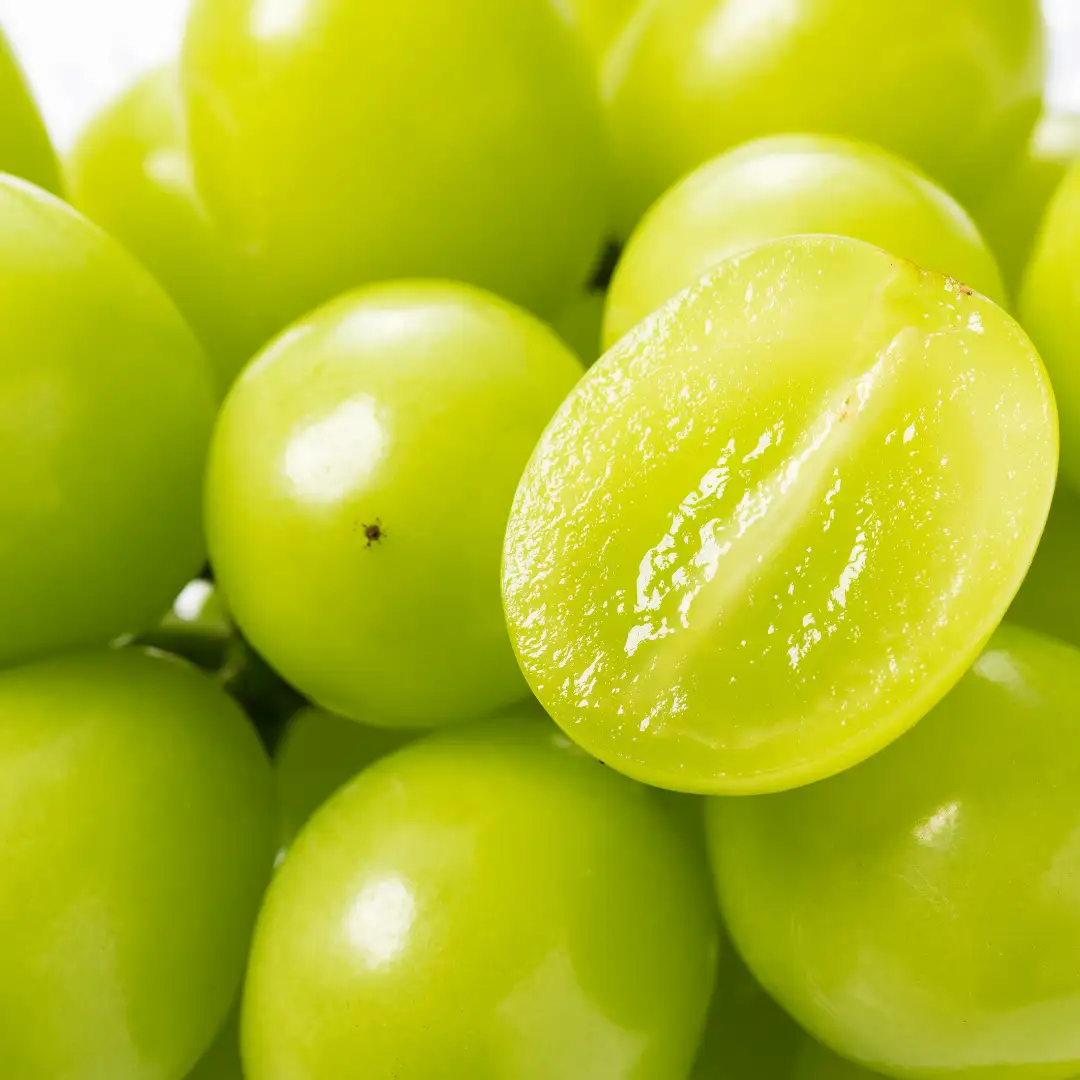
As for peels, while they can pack a punch in terms of nutritional value, washing them thoroughly to remove any pesticides or opt for organic produce when possible is essential.
With stems, some, like those from leafy greens, are fine in moderation, but always do a quick check to make sure they’re safe and not too harsh, as they can cause digestive issues. I always quickly inspect stems before they hit the cage floor to avoid any tummy troubles.
Are Raisins a Safe Bet? 🍇
Let’s chat about raisins, those teeny dried grape morsels—they seem like they’d be packed with vitamin C and an easy snack, right? Well, they are certainly full of concentrated nutrients, but raisins have even more sugar than fresh grapes. Consequently, they should be fed to your guinea pigs more sparingly than their juicy counterparts—if at all.
Remember, we aim for a round of delighted wheels, not digestive upset or health woes. Keep those raisins rare and precious, like a tiny treasure in their menu.
How to Serve Grapes to Guinea Pigs
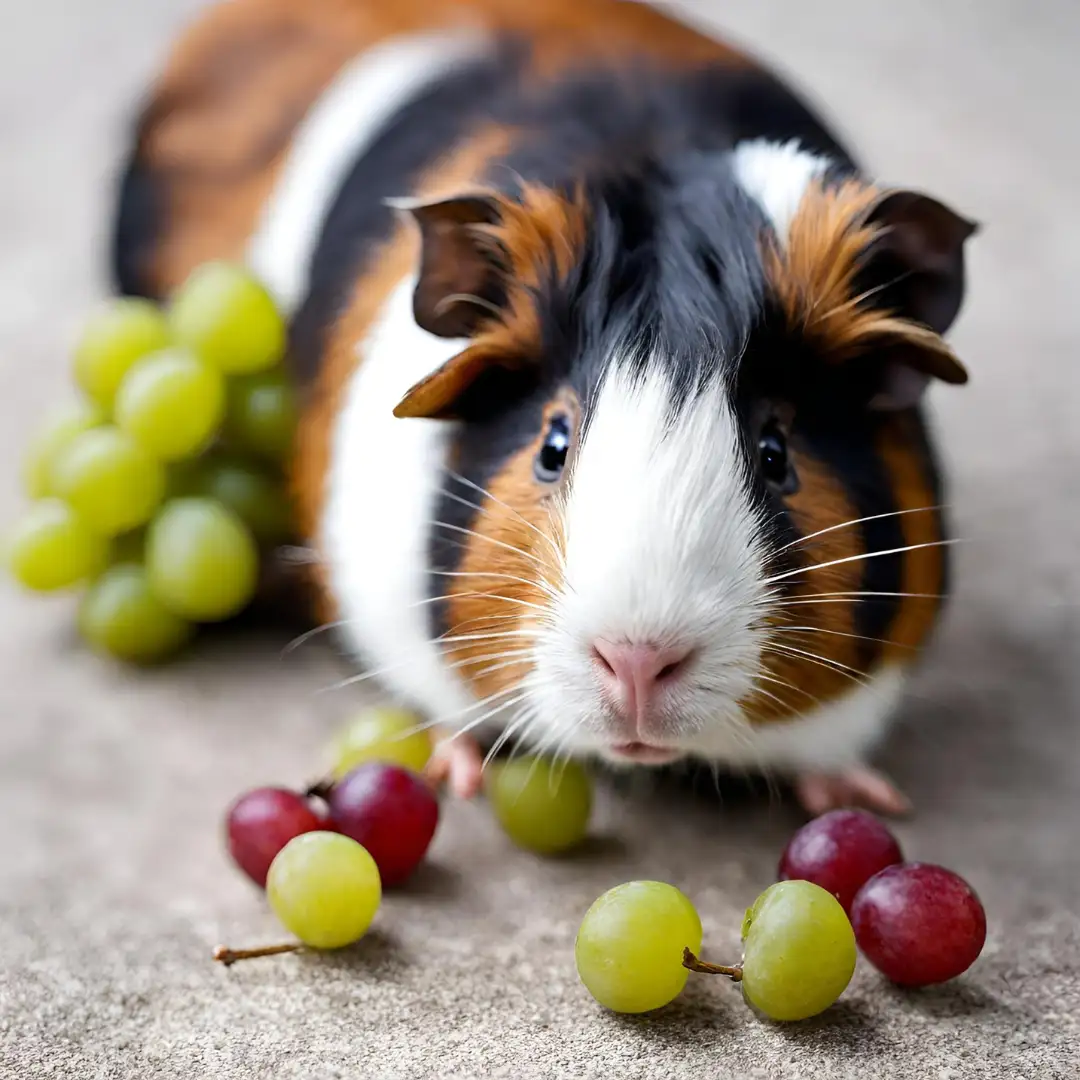
When it comes time to feed your fuzzy friends a grapey treat, there’s a little more to it than just plucking a grape from the bunch and presenting it to your pet. Here’s how I make sure the grapes are suitable for my little companions:
- First off, I always go for green, seedless grapes. 🍇 They’re lower in sugar than their red or black counterparts. Without seeds, you eliminate the risk of any accidental choking. When I’m at the store or farmers market, I choose the firm and plump grapes—avoiding any shriveled or blemishes.
- Once back in the kitchen, the grapes thoroughly rinse under cool water to wash away dirt or residues. This step is super important!
- Then I pat them dry with a clean towel because nobody likes a soggy snack, least of all my guinea pigs.
- Now, even though they’re seedless, I still take the time to cut the grapes into halves or, depending on their size, sometimes even smaller pieces. This is all about portion control and ensuring my pets can easily manage these tasty bites without overeating. Plus, it makes the grapes way easier for them to handle and munch on. 🍴
It’s crucial to remember that we’re talking small amounts here—it’s a treat, not a meal, so moderation is key. I usually give just one half per guinea pig to avoid any issues with them overeating sugar. That way, they get all the enjoyment without any health concerns toxic foods could present.
And voilà! That’s how I serve a safe and enjoyable grape treat for my furry family. It’s always one of the day’s highlights when those little paws start grabbing and munching away. 🌟
Other Fruits to Use as Treats
Apples 🍎 are a hit in my house—crunchy, juicy, and full of fiber! But remember, moderation is key 🔑. A small slice of apple here and there is more than enough for them.
And who can forget about berries? Strawberries 🍓, blueberries, and even little pieces of watermelon 🍉 (minus the seeds, of course) are like a burst of summer joy for guinea pigs.
I feed them these treats sparingly because of their high sugar content. Just a couple of times a week is plenty. I always remember to wash them thoroughly and cut them into manageable sizes.
Oranges 🍊 are another great source of vitamin C for guinea pigs, but I only offer a tiny segment occasionally to avoid mouth sores—citrus can be pretty acidic, after all. It’s all about balance and ensuring our pint-sized pals have a feast fit for a king while keeping their health in check.
Wrapping Up
Can guinea pigs eat grapes? Yes! Can guinea pigs eat apples? Yes, they totally can! Can guinea pigs eat watermelon? Of course!
Remember to serve them in moderation as a special treat. And always remember to introduce new foods slowly and watch for any adverse reactions.
With a little research and careful consideration, we can provide our guinea pigs with a well-rounded, nutritious, delicious diet! 🍇🍎🐹

